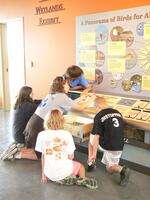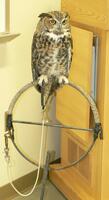School Programs
Science- and Nature-based School Programs
The Kansas Wetlands Education Center offers several science- and nature-based school programs as field trips or outreach in your school classroom or facility.
Programs for kindergarten students are generally 30 minutes long, with all other programs 45 minutes to one hour, depending upon student age and class needs. Programs are provided free of charge and feature live animals and plants, where possible, and/or hands-on materials and activities. Programs combining nature hikes with classroom time may be 1 ½ hours long.
There will be a charge for programs scheduled with less than two weeks notice and a mileage fee may be charged for those schools located over 75 miles away from KWEC.
At the end of each program description is a list of state science standards met for each age group. Some programs are more suited to younger students and others to older children but can be adjusted. Please refer to the science standards for age appropriateness.
If you don’t see a program topic you are interested in, please contact us, modifications can be made to existing programs or new programs developed to meet curriculum needs.
The maximum number for classes is 30 students but larger groups can be accommodated by rotating students among several programs/activities. For hikes, 25 or less students are preferred.
To schedule a program, or for more information, please call KWEC at 620-786-7456, Tuesday through Friday, 8 a.m. to 5 p.m., and ask for Pam Martin, or use the email form. Please try and call at least two weeks before your desired program date.
A Butterfly’s Journal
Focusing on the Monarch butterfly, students will learn the butterfly’s life cycle, biology and behaviors, and follow the Monarch’s fantastic journey to Mexico and back north in the spring. Information on tagging of the butterflies will also be included. Program may be conducted as a field trip to KWEC, with students going forth to capture and tag Monarchs, or in the classroom with a tagging demonstration. Tagging portion of the program is limited to the months of August, September and possibly early October.
Meets science standards: Grades K-2 – 1.1.1, 1.1.3, 3.1.1-2, 3.1.4,5.1.2; Grades 3-4 – 3.1.1-3,3.2.1,5.2.4, 7.1.1; Grades 5-6 – 3.3.1-2, 3.5.2-3,6.2.1
Cheyenne Bottoms’ Spring Chorus
In addition to learning the frog and toad life cycle, students will learn how, why and where frogs and toads call. Power point presentation provides actual calls and hands-on activities are used to replicate calls. Students discuss habitat stresses due to human influence. Live animal representatives used if available.
Meets science standards: Grades K-2 – 1.1.1, 1.1.3, 3.1.1-2, 3.1.4; Grades 3-4 – 2.3.1-3, 3.3.1, 3.2.1, 6.2.1; Grades 5-6 – 3.2.1, 3.3.1-2, 3.5.1-3
Birds: Nature’s Marvelous Flying Machines
This program may be presented in two ways – an overview of bird adaptations or broken down into detailed information about each adaptation. (For grades 3-6)
“Create a bird” - Allows students the opportunity to make their own bird and describe its special features, after discussing bird adaptations.
Individual adaptation programs:
"The Case of the Hungry Owl" – Students put their detective skills to work and solve the mystery of what creatures the Cheyenne Bottoms barn owls are capturing and eating. Participants will dissect barn owl pellets, meet one of the culprits and identify victims.
“Flight” – Students observe parts of the feather, different types of feathers and how birds stay in the air. Hands-on activities to understand flight, including making an eagle airplane.
“Bills and Feet” – After learning how birds’ beaks and feet come in all sizes and shapes, and how each is matched to the food the bird eats, students will participate in an activity matching “tools” to beaks. This program can also be matched with a nature hike to observe birds in different habitats.
“Have Wings, Will Travel” – Many birds migrate to breeding grounds in the spring and to warmer climates in the fall. Students will investigate why birds migrate and the mechanisms at work.
“Home Life” – Birds make many different types of nests in many different ways. Children will explore courting, nest building and brooding behaviors and differences in eggs.
Meets science standards: Grades 3-4 – 1.1.1, 1.1.3-4, 3.1.1-3, 3.2.1; Grades 5-6 – 3.2.1-3, 3.3.1-2, 3.5.1-3
Making Tracks – Identify animals by the tracks they make in earth and snow; includes a track activity and making a plaster track cast for the classroom. This program could also be combined with a hike to find and identify tracks.
Meets science standards: Grades K-2 – 1.1.1, 1.1.4, 3.1.1, (3.1.3 if take nature hike), 3.1.4; Grades 3-4 – 3.1.1, 3.1.3
Is it reptile or amphibian? – Students learn the difference between reptiles and amphibians and how to classify them, with the help of some live animal representatives. They will also gain an understanding of the terms cold- and warm-blooded.
Meets science standards: Grades K-2 – 1.1.1-5, 3.1.1-4; Grades 3-4 – 3.1.1-3, 3.2.1
Wonderful Wetlands – Students learn the food cycle/web of a wetland, specifically Cheyenne Bottoms, through an activity in which they add the plants and animals living in the Bottoms to a marsh backdrop and answer the question “what happens when one of the elements is removed?” Live examples of amphibians, reptiles, birds and mammals are also used. Program could also be combined with outdoor hike to view the wetland at KWEC.
Meets science standards: Grades K-2 – 1.1.1-2, 1.1.4, 3.1.1-4; Grades 3-4 – 3.1.1-3, 3.2.1, 7.1.1; Grades 5-7 – 3.3.1-2, 3.4.1-3
Outdoor programs available at Kansas Wetlands Education Center during spring and fall seasons
Habitat/Seasonal hike
Students compare and contrast habitats – marsh, grassland and wooded – and the different animals and plants that live in each. The hike also illustrates food chains. Seasonal changes are also observed.
This hike may also be scheduled during winter; weather permitting and provided students are dressed for the cold. Children often enjoy searching for tracks in the snow and other evidence there is life where there appears to be none at first glance.
Meets science standards: Grades K-2 – 1.1.1-4, 2.1.1-2, 3.1.1-4, Grades 3-4 – 3.1.1-3, 3.2.1, 4.2.3, 7.1.1; Grades 5-6 – 3.4.1-3, 3.5.1
Wetland study
After observing animals and plants living in a wetland, water samples are collected, taken in to the classroom and observed under a microscope. Program can be expanded to include water quality indicators.
Grades 3-4 – 2.1.1-3, 3.1.1-3, 3.2.1,6.2.1-1, 7.1.1; Grades 5-6 -3.1.1, 3.2.1, 3.3.2, 3.4.1b, 3.4.3a, 3.5.1b, 6.2.1, 6.3.1
Insect Search
With nets and containers in hand, students search out invertebrates living along the nature trail. Magnifiers and microscopes will be used for closer examination and identification/classification.
Grades K-2 – 1.1.1-4, 3.1.1-4; Grades 3-4 – 2.1.2-3, 3.1.1-3, 3.2.1, 7.1.1; Grades 5-6 – 3.1.1, 3.2.1, 3.3.2, 3.4.1, 3.5.1b
SPECIAL PROGRAMS
Kansas Day Symbols
This program is geared for the month of January, but could be given at any time of the year. From the mighty American bison to the tiny European honeybee, students will learn fascinating facts about the Kansas animal and plant symbols. Students have a chance to feel a bison hide, see a live barred tiger salamander and ornate box turtle and experience how a bee sees the world, among many other hands-on activities.











